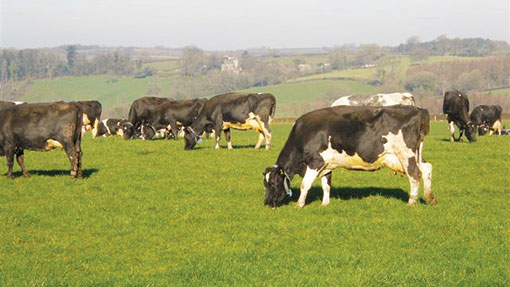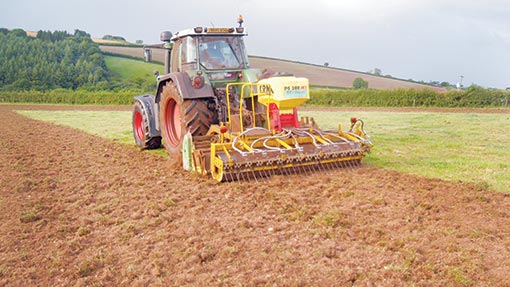Organic grassland management increases yield from forage

Improved grassland management has enabled an organic dairy farm to increase cow numbers and milk from forage without increasing grazing area.
Alan and Donna Webber, who milk a herd of three-way cross dairy cows at Hensley Farm, Devon, switched from rotationally grazing fields to a series of smaller paddocks six years ago, in order to grow more grass more quickly.
Profiting from organic grazing can be tough without having access to conventional quick fixes from a bag. But this has not stopped Mr Webber from boosting grassland productivity, enabling the herd size to increase by a third to 200 head, with 62% of yield now coming from forage alone.
His motto for successful grass management is: “When grazing grass, don’t keep looking in the tank, look at your fields.” And it’s the strictly managed paddocks Mr Webber believes are essential in increasing output from forage of his autumn block-calving herd.
Paddock grazing
The cows are moved to a new paddock every 12 hours after milking. When grass is growing well, cows are on a “21-day round”, which means Mr Webber aims for them to be back in their starting paddock after 21 days. As grass growth slows, this extends slightly to a 30-day round.
“Cows go in at 2,600kg/ha of DM and we aim to graze down to 1,500kg/ha of DM. If it goes over 3,000kg/ha of DM this is taken out for silage,” explains Mr Webber.
“You need to graze grass in order to grow the most grass possible,” he adds.
See also: More on precision grassland management
By investing £10,000 into a new ring-main water supply and 40 drinking troughs, Mr Webber now has huge flexibility in paddock arrangements. Because of this, he can maximise grass use and predicts a three-year return on investment.
Cow track infrastructure is also important to the system. The first one put in 10 years ago is now too narrow for the expanding herd. Today, 15-18ft wide tracks access all paddocks, minimising grass damage and helping extend grazing into the “shoulders of the season” [mid-February to March and October to early December].
Mr Webber breeds a lighter cow to suit the extended grazing season. The cows are a three-way-cross breed of black and white, Swedish Red and Montbéliarde.
“We’re trying to build a cow with good feet and legs that’s not too big or it would be too heavy for our grazing conditions, but it needs to have a good body capacity to eat plenty of forage,” he says.
Grass type
Choice of grass seed to suit the organic system is vital when not having free access to artificial fertiliser. Half of Mr Webber’s 73ha of adjoining grazing are temporary leys, reseeded six years ago mainly with an intermediate late perennial ryegrass.

“We get our soil tested every three years by our seed merchant who advises us on our leys and the right type of grass seed for our dry, free-draining soil. This was chosen for its disease resistance, good feed quality characteristics and palatability. It also has good durability for extended grazing.”
Permanent pasture makes up the other half of grazing, and this is also carefully managed to improve productivity. However, with areas too steep to plough and being unable to spray the old grass off, Mr Webber has trialled rejuvenating these areas by rotavating, reseeding and rolling, on top of old grass.
“We aim to reseed 15% of the total grazing area each year in this way. Hopefully we’ll get in a cycle to produce more grass in our permanent pasture,” he says.
Fertiliser
With the only source of fertiliser coming from untreated slurry produced by the cows, and most of this being sprayed on silage ground, Mr Webber experimented with subsoiling last autumn to push grass growth. He estimates 15-20% more grass was grown on the subsoiled paddocks for the remainder of the season and will definitely be repeating the process this year.
Manipulating fencing to keep cows on sloping pasture ensures even less favourable areas are fully grazed. As cows naturally choose to spend more time at either the top or bottom of the slopes, salt is also applied to these areas to sweeten pasture and encourage uniform grazing.
Weed management, particularly docks and thistles, can often try the patience of the most progressive organic farmers. But, Mr Webber’s solutions are two-fold: pre- or post-mowing when necessary to cut the pasture back clean, but mainly tightly grazing so only the grasses have chance to come through
Benefits of the organaic system
Attention to strict grassland management has enabled Mr Webber to cut costs while increasing yields and cow numbers.
Growing more grass and grazing tighter on the same acreage is supporting an expansion in herd size by 10 cows a year and stocking densities from 2.2 cows/ha to 2.7 cows/ha, while increasing yield from forage (see graph).
Cows aren’t buffer fed during the summer, as according to Mr Webber this can “seriously mess up” good grazing.
“If they know there’s nothing indoors to eat they will graze down tightly. Topping up with feed inside to get extra litres often wastes grass outside,” he says.
As a result feed costs have also been cut by extending the grazing season and improving grass quality. “Cows eat less produced forage and more grazed grass, and as soon as the grass is growing well, any cows giving less than 21 litres a day receive no supplementary feed as good-quality grass should sustain them for that many litres a day,” says Mr Webber.
The shorter housing period has also resulted in some savings. “We spend £20 a day on sawdust and lime and £20 on diesel in the yard scraper every 10 days. These costs are halved when the cows go out,” he says.
Grass Prix winners
Winners of the Yara Grass Prix 2012 produced a grass yield of 13,200kg/ha of DM with an average digestibility value of 700g/kg of DM. The triumphant husband and wife team are Jyrki and Tiina Heinonen of Finland, who farm a small herd of 29 cows. Because of the high energy and intakes of their grass, milk yield is an impressive 10,813kg a cow.
The top three grass prix contestants averaged grass yields 2.4 times higher than other grass farmers in Finland. A team of experts guided the Heinonen’s before and during the contest, resulting in average milk yield increases of 550kg a cow a year.
“The growth condition of soil has to be good; this had to be altered before the contest. After the basic elements are ok (pH, fertility, drainage, shape of the fields, dense grass of appropriate varieties without weeds), it’s reasonable to put maximum fertilisation to the field and get a high yield from it,” says Mr Heinonen.
According to Minna Toivakka, competition organiser and development manager at Yara Crop Nutrition, the lesson for farmers is simple: “Investing in grassland fertilisation for higher yields is worth it,” she says.
She explains how Finnish farmers often calculate how much money they can save, rather than how much return on investment they could make. In grass production, Ms Toivakka says farmers who invest in variable costs such as fertiliser, seed, silage additives and herbicides can make much higher profits due to a larger better quality yield. “Doubling of grass yield means farmers need half the grassland area, or they can almost double the herd size,” says Ms Toivakka.
Visitors to the Grassland and Muck Event on 21 and 22 May will be able to see a wide range of grassland machinery on display and meet more than 240 exhibitors with the latest products and innovations. They can also see muck spreading equipment in action and earn four BASIS points for attending.
Aside from practical demonstrations there will also be grass and muck forums with topics such as feeding grass for milk production and managing muck for profit. Tickets are on sale now with an advance ticket price for an adult of £15.50 compared with £19 on the gate. Book now at www.grasslandevent.co.uk
